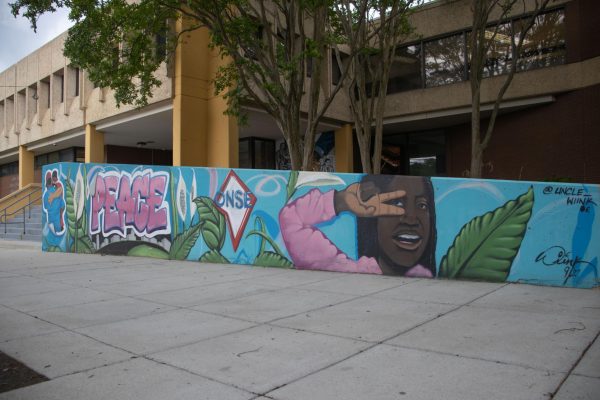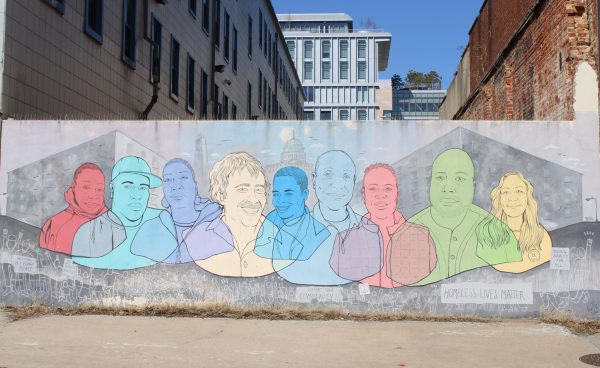My Body, Whose Rights?
Planning For Parenthood
Originally published in Spring 2017, Issue 21.
On Sept. 26, 2016, celebrities, politicians, activists and health care professionals gathered to celebrate the opening of a Planned Parenthood Health Center in D.C. a block from the NoMa-Gallaudet metro stop. Pro-choice groups held signs saying “my body, my rights,” while anti-choice groups held signs reading “fetuses have beating hearts.”
This women’s health center is the only one in D.C., making it the third in the D.C. metropolitan area. Before, the closest center was in Silver Spring, Maryland.
Bill Albert is the chief program officer for The National Campaign to Prevent Teen and Unplanned Pregnancy. This organization works to decrease unplanned pregnancy by ensuring access to contraception and runs health centers like Bedsider Birth Control Support Network. He says the anti-abortion activists have flawed logic.
“Providing women with better access to all methods of contraception helps prevent unplanned pregnancy, and of course unplanned pregnancy is at the root of almost all abortions,” Albert said. “So for those who are opposed to abortion, the best thing to do is to be a strong supporter of contraception.”
This Planned Parenthood will provide services such as birth control, emergency contraception, abortions and testing for sexually transmitted diseases. Before, these services were provided by various women’s health centers.
Whether these services will continue to be provided is unclear as D.C. lacks statehood. One move against abortion access is H.B.7, a bill passed in January that bans any federally-funded facilities from providing abortions and all federally-funded insurance plans from covering abortion. The bill also defines the D.C. government as part of the federal government, thereby preventing D.C. from locally funding abortion or insurance that covers abortion.
These bans on federal funding for abortion services disproportionately affect those on Medicaid, a federal health care system for low-income residents. According to the Kaiser Family Foundation, a non-profit organization dedicated to health policy analysis, nearly 265,000 D.C. residents were enrolled in Medicaid as of December 2016. This is more than one-third of D.C.’s total population. Comparatively, only a little over 20 percent of the US population is enrolled in Medicaid.
The unusually high percentage of D.C. residents who rely on Medicaid speaks to the larger issue of poverty in the D.C. area. Officially 19 percent of residents are below the national poverty line. When the cost of living was accounted for by an alternate measure of poverty used by the Census Bureau, this number rises to about 23 percent.
Emily Stephens is the co-president of H*yas for Choice, a club at Georgetown University that focuses on ensuring students’ access to contraceptives. Because the club distributes condoms, the university does not fund them due to the conflicts with Catholicism. Stephens says that the potential repeal or alteration of the Affordable Care Act could have dangerous consequences for college students, especially low income ones.
“The contraceptive mandate in the Affordable Care Act requires organizations to cover contraception,” Stephens said. “So if that changes, which it definitely could given the current political atmosphere, students on student health insurance could be left without access to covered birth control. On Georgetown’s campus that definitely has a disproportionate effect on low-income women.”
Reproductive and sexual healthcare has always attracted controversy. Since Margaret Sanger popularized the birth control movement in the early 1900s, access to such resources has stood for much more than healthcare: It has been a fight for women’s ability to make choices about their health. Sanger founded the American Birth Control League, which later became known as Planned Parenthood. The Trump administration has promised it would defund Planned Parenthood.
“I think the threat to defund Planned Parenthood in saying that money can be transferred to other clinics instead of Planned Parenthood just doesn’t comport with the facts,” Albert said. “Our research shows that in 105 counties in this country, Planned Parenthood is the only game in town for providing the full range of contraceptive methods.”
The Trump administration isn’t the first to attempt to defund Planned Parenthood. The Hyde Amendment, a frequently cited legislative move against abortion access, was passed in 1976.
The Hyde Amendment affects low-income women by preventing the use of Medicaid funds for abortion services. According to Kaiser Family Foundation, 17 states use local funds to cover abortion services. These states bypass the effects of the Hyde Amendment. But D.C. and 33 states rely on extremely limited federal funds. This is especially harmful to low-income women who must pay out of pocket, except in cases of rape, incest and when a woman’s life is in danger.
Hyde is not the only case where the federal government has used its influence over D.C. to prevent the city from funding abortions or reproductive healthcare. Since the new administration took office, there have been numerous attempts to defund abortion.
Studies, like one from the Brookings Institution, show lower income women are less likely to use contraceptives and are more likely to have unintended pregnancies than wealthier women. This means the very women who need health care, like that provided by Planned Parenthood, are the ones who have less access to it because Medicaid often does not cover these services or facilities.
Unless there is separate state funding, which is not available in D.C. because locally raised funds in D.C. are considered federal, Medicaid can only cover services at facilities that do not perform abortions. This eliminates many clinics such as Planned Parenthood.
Despite the recent opening of a Planned Parenthood in D.C., reproductive and sexual healthcare remains out of reach for many. Getting an appointment at the health center is a challenge in itself.
Scheduling is available online up to three weeks in advance; however, getting a weekend appointment is nearly impossible. While the center in D.C. has extended evening hours on Tuesdays and Wednesdays, lasting until 7 p.m., but these appointments are also inaccessible. This leaves only weekdays, which for some, means missing work or school.
Another aspect that stands in the way for some D.C. women is distance and travel time. A study by the RAND corporation found that, of the eight wards D.C., Wards 7 and 8 have the highest teen pregnancy and STI rates. Getting to the new health center from these areas can take over an hour using public transportation. Even though the opening of a health center in D.C. has made healthcare more accessible, it is still difficult for many women in D.C. to access the services they need.
According to Guttmacher Institute, 20 million women in this country are in need of publicly-funded contraceptive services. According to the National Campaign to Prevent Teen and Unplanned Pregnancy, 19.7 million women live in contraceptive deserts. This means they lack reasonable access to a public clinic with the full range of methods.
“Considering the power that congress has over D.C.’s budget, I think there are some unique challenges for DC women,” Stephens said.
Marney Wood is a first-year student studying international studies and minoring in theatre and public health.






